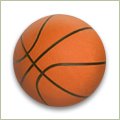
In response, I sent him a handout which he will soon publish in an interview script. If you already receive his newsletter, wait for my next post, but if you don't, then read on to learn more about a common condition that is close to my heart (and both my knees, as I had it back when I was 12).
What is it?
Osgood-Schlatter Disease (OSD) is a common overuse injury that causes pain, swelling and tenderness just below the kneecap. The tender point is the “tibial tuberosity”, where the kneecap tendon attaches to the tibia (shinbone).
Knee pain from OSD worsens with activity, kneeling, and trauma to the tender point below the knee. The tender point may start to stick out, causing a bump in the bone below the kneecap. While the pain is a temporary condition and generally improves with rest, the bump below the knee may remain.
Who gets it?
It occurs in children (especially gym rats) who participate in sports that require lots of running and jumping (like basketball) while they are going through their growth spurts. In boys, this usually occurs between the ages of 13 to 15 and in girls, it usually happens between the ages of 10-12. The pain occurs gradually over time as the young athlete continues to play and grow.
Why does it happen?
During running, jumping and landing, the front thigh muscles (quadriceps) pull on the kneecap and the kneecap tendon. If the amount of activity is too great, it can start to pull the tendon off the raised area of the tibia/shin bone where it attaches, causing inflammation of the growth cartilage, pain at the site and a bony bump under the knee. During rapid growth (a growth spurt), tendons can become tighter, leading to a loss of flexibility and more pull where they attach to the bones.
How long does it last?
The pain of OSD can come and go, depending upon the degree of injury and the player’s activity level. While OSD can last months to years, it is a temporary condition that improves with a decrease in activity and usually goes away when a child has finished their growth spurt.
How do you know it’s OSD?
On a visit to your local doctor, they should examine your knees and hips for strength, swelling, stability, pain, and range of motion. They’ll look for the tenderness (and bump) below the knee. They may also get an x-ray of your knees (and hips). No blood tests or advanced imaging (CT scan, MRI) are usually needed. If the history, physical exam, and x-ray findings all suggest OSD, then the diagnosis is made.
What can you do about OSD?
Once the diagnosis is made, then you can decide upon the best treatment plan for you. While it can be extremely frustrating, the best treatment is REST.
In milder cases, you can use a knee pad to protect the tender point, making sure you stretch the thigh muscles frequently, and use ice and non-steroidal anti-inflammatory medicines (like ibuprofen) after a game/practice to reduce the pain and swelling. You can also try wearing a patellar strap to decrease the tension on the tender point area. In most cases, playing with mild OSD should not cause it to last any longer or cause damage. But if the pain makes it hard to just get through everyday life activities like walking or climbing a set of stairs, then your body is telling you something and you need to listen to it and stop playing for a while.
If you do the above, but the pain doesn’t go away, your doctor might put you in a knee brace or on crutches to rest your leg. That doesn’t mean you should stop exercising – I’d suggest you consider staying in shape by swimming, doing aquatic therapy, or bicycle riding (if OK’d by your local doctor). Once the pain is gone and you’re cleared by your doctor, make sure that you also work to improve your strength, flexibility, balance, and conditioning before you return to playing.
DON’T keep playing through severe pain. This might worsen the condition and even cause the bone to break off at the tender point. Playing with pain and swelling in your knee will also make you more likely to sustain a different injury in the knee, hip or ankle.
In the very rare case where the pain continues even after your growth spurt is over, a bone doctor can perform surgery that fixes the problem and takes away the pain.
What can you do to prevent it?
Stretching the quadriceps muscle on the front of the thigh helps to reduce the pull of the muscle on the kneecap and tender point. You can also work to strengthen and stretch the hamstring muscles on the back of your thighs (which, by the way, can also help you run faster). Making sure you warm your muscles up well before exercise and stretch and cool down afterwards can also help. Remember, it’s the repetitive stress on the knee during a growth spurt that causes this condition and makes the pain worse. The best treatment for this condition is a temporary reduction in playing and practicing.













































